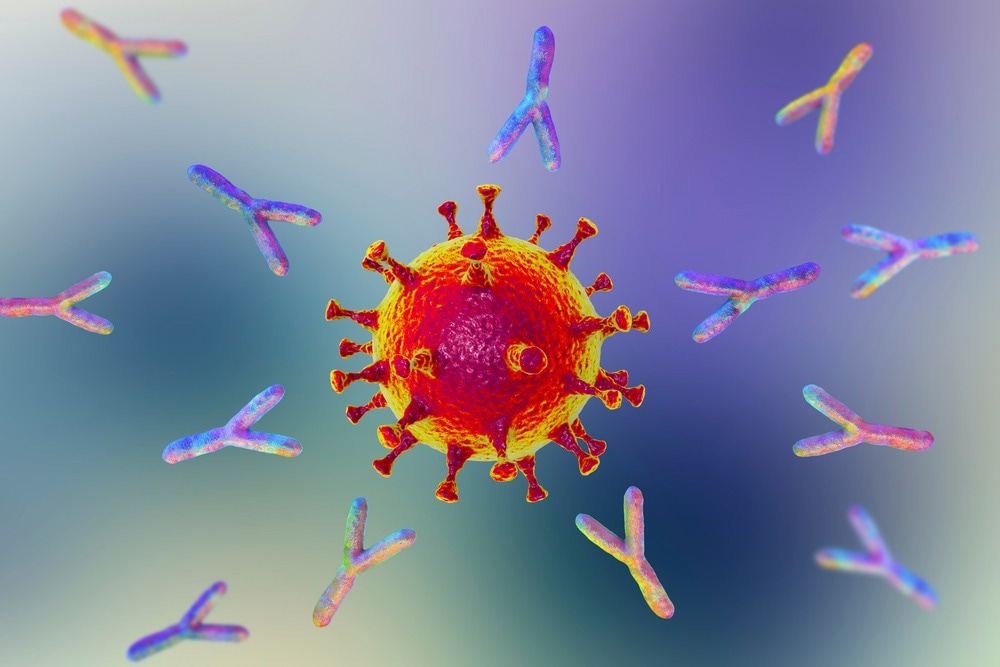Individuals infected during the initial coronavirus disease 2019 (COVID-19) waves, before the extensive COVID-19 vaccine rollout, were assessed.

Study: The Breadth of the Neutralizing Antibody Response to Original SARS-CoV-2 Infection is Linked to the Presence of Long COVID Symptoms. Image Credit: KaterynaKon/Shutterstock.com

 *Important notice: medRxiv publishes preliminary scientific reports that are not peer-reviewed and, therefore, should not be regarded as conclusive, guide clinical practice/health-related behavior, or treated as established information.
*Important notice: medRxiv publishes preliminary scientific reports that are not peer-reviewed and, therefore, should not be regarded as conclusive, guide clinical practice/health-related behavior, or treated as established information.
Background
Data on the relationships between longitudinal dynamics and the SARS-CoV-2 neutralization breadth with long COVID (LC) phenotypes before COVID-19 vaccination are limited.
The capacity of antibodies to cross-neutralize multiple SARS-CoV-2 VOCs might be related to the existing pathology and persistent COVID-19 symptoms.
About the study
In the present study, researchers determined the association between the durability and breadth of initial Ab responses and LC symptom presence.
The team longitudinally assessed nAb responses to pre-Omicron and Omicron VOCs among individuals infected during the initial pandemic before COVID-19 vaccination.
Longitudinal mixed effects-type modeling and cross-sectional regression-type were performed to assess the influence of the nAb breadth and decay rates on LC symptom development and associated phenotypes.
The study comprised the University of California, San Francisco (UCSF)-based long-term impact of infection with novel CoV (LIINC) study participants.
At follow-up, participants completed questionnaires to provide data on new/persistent COVID-19 symptom presence. In addition, blood samples were obtained from the participants (n=184) between one and four months after COVID-19 symptoms.
The samples were obtained before the participants received COVID-19 vaccines, during the initial COVID-19 waves, and before Delta VOC emergence.
SARS-CoV-2 neutralizing Ab assays were performed. Neutralizing activity of the Ab was measured by evaluating luciferase activity inhibition among human embryonic kidney (HEK)293 cells that expressed angiotensin-converting enzyme 2 (ACE2) and transmembrane serine protease 2 (TMPRSS2) after pre-incubating the human immunodeficiency virus-1 (HIV-1) pseudovirions with participant sera.
Results
Several new associations were observed between SARS-CoV-2 Ab neutralization and the presence of LC symptoms.
Although nAb responses to the original SARS-CoV-2 strain were not linked to LC in cross-sectional analyses, cross-neutralization of 50% inhibitory concentration (ID50) levels to BA.5 four months following acute COVID-19 was independently and significantly related to greater LC odd, with persistent neurological and gastrointestinal symptoms.
A greater fraction of individuals had antibodies that could neutralize Omicron BA.5, compared to Omicron BA.1 or XBB.1.5 VOCs.
The LC group was enriched by females (58%), those who were hospitalized during acute SARS-CoV-2 infection (25%), individuals with a previous history of autoimmune diseases, especially thyroiditis (11%), individuals of Latin ethnicity (35%) and individuals with high body mass index (BMI) values (28 kg/m2). The breadth of nAb responses was associated with increased LC odds.
The nAb responses were persistently greatest to the ancestral SARS-CoV-2 strain, Alpha VOC, Beta VOC, and Delta VOC, with levels reducing after one to four months of acute COVID-19.
Across the time intervals, 13% of nAb titers were under assay positivity level for the original SARS-CoV-2 strain, and 78.0% and 67.0% below that for Omicron BA.1 sub-VOC and the BA.5 sub-VOC, respectively.
Comparable nAb titers for BA.5, BA.4.6, and BQ1.1 were observed, and XBB.1.5 nAb titers resembled those of Omicron BA.1 the most, being low to negative among the participants.
Ab neutralization ID50 reduced over time across the SARS-CoV-2 strains, except BA.1, which showed much lower initial titers than other VOCs. The male gender was linked to greater SARS-CoV-2 neutralization for the ancestral strain, Delta VOC, and BA.5 sub-VOC across time intervals.
For individuals with acute COVID-19-associated hospitalizations, neutralization was significantly greater across all strains except BA.1 sub-VOC. The team observed 1.2 and 0.9 log10 greater nAb titers for the ancestral strain and Delta VOC vs. 0.3 log10 greater for the BA.1 sub-VOC and Omicron BA.5 sub-VOC.
The extent of SARS-CoV-2 wild-type responses for individuals with BMI ≥30.0 was greater at all time intervals for the ancestral strain and Delta VOC and reduced more swiftly for the ancestral strain and Delta and BA.5 VOCs.
Contrastingly, neutralization ID50 from individuals with diabetes was lower at all time intervals for the ancestral SARS-CoV-2 strain, and ID50 values for the ancestral strain and the Delta VOC reduced more steadily.
Cross-neutralization ID50 values to Omicron BA.5 were positively and significantly associated with gastrointestinal and neurocognitive symptoms.
Cross-neutralization to Omicron BA.5 was significantly associated with any LC and neurocognitive symptoms. Individuals with cardiopulmonary and gastrointestinal symptoms had 0.3 and 0.4 log10 greater neutralization ID50 than those without.
Decay in neutralization ID50 was faster among individuals with musculoskeletal and cardiopulmonary symptoms than those without.
In the sub-analysis of samples from 16 individuals, consistently greater cross-neutralization with BA.2, BA.4.6, and BQ.1.1 sub-VOCs was observed. Contrastingly, lower neutralization ID50 values to XBB.1.5 pseudovirus were observed, similar to BA.1 neutralization.
Conclusion
The study findings showed that a greater neutralization response waning more swiftly or remaining broad over time relates to LC.
The association between the immunological responses and LC is probably complex but might involve Ab neutralization response breadth.

 *Important notice: medRxiv publishes preliminary scientific reports that are not peer-reviewed and, therefore, should not be regarded as conclusive, guide clinical practice/health-related behavior, or treated as established information.
*Important notice: medRxiv publishes preliminary scientific reports that are not peer-reviewed and, therefore, should not be regarded as conclusive, guide clinical practice/health-related behavior, or treated as established information.